Combating Smoking with Digital Campaigns
VerifiedAdded on 2020/05/28
|20
|3845
|108
AI Summary
This assignment delves into the development and execution of digital campaigns aimed at reducing smoking rates. It examines various aspects such as target audience identification, content creation, platform selection, campaign dissemination, and success measurement through surveys. The focus is on utilizing social media, websites, and online advertising to effectively raise awareness about the dangers of smoking and encourage cessation.
Contribute Materials
Your contribution can guide someone’s learning journey. Share your
documents today.

Running head: HEALTH PROMOTION CAMPAIGN
Health Promotion Campaign: Prevention of Smoking
Name of the Student
Name of the University
Author Note
Health Promotion Campaign: Prevention of Smoking
Name of the Student
Name of the University
Author Note
Secure Best Marks with AI Grader
Need help grading? Try our AI Grader for instant feedback on your assignments.
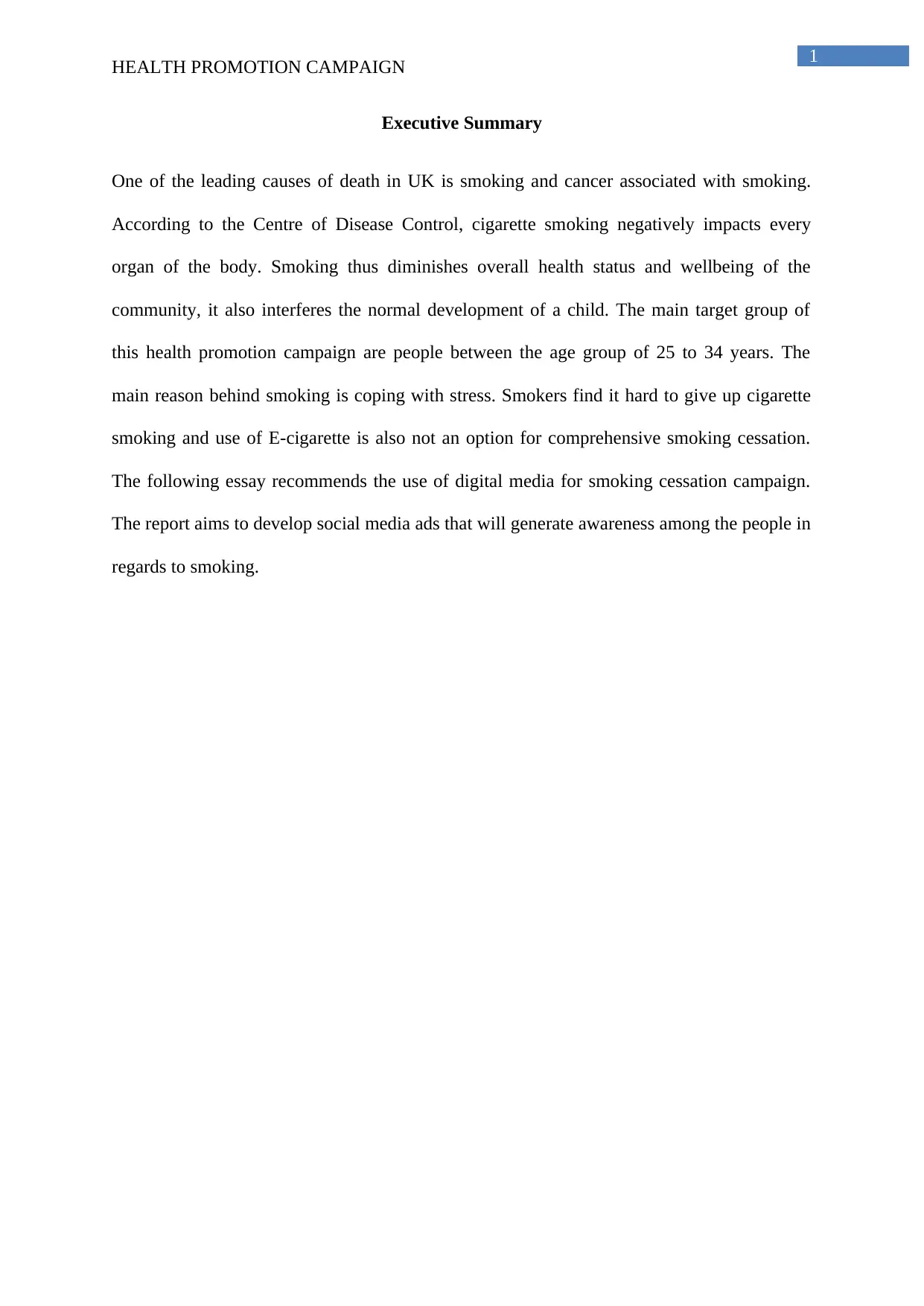
1
HEALTH PROMOTION CAMPAIGN
Executive Summary
One of the leading causes of death in UK is smoking and cancer associated with smoking.
According to the Centre of Disease Control, cigarette smoking negatively impacts every
organ of the body. Smoking thus diminishes overall health status and wellbeing of the
community, it also interferes the normal development of a child. The main target group of
this health promotion campaign are people between the age group of 25 to 34 years. The
main reason behind smoking is coping with stress. Smokers find it hard to give up cigarette
smoking and use of E-cigarette is also not an option for comprehensive smoking cessation.
The following essay recommends the use of digital media for smoking cessation campaign.
The report aims to develop social media ads that will generate awareness among the people in
regards to smoking.
HEALTH PROMOTION CAMPAIGN
Executive Summary
One of the leading causes of death in UK is smoking and cancer associated with smoking.
According to the Centre of Disease Control, cigarette smoking negatively impacts every
organ of the body. Smoking thus diminishes overall health status and wellbeing of the
community, it also interferes the normal development of a child. The main target group of
this health promotion campaign are people between the age group of 25 to 34 years. The
main reason behind smoking is coping with stress. Smokers find it hard to give up cigarette
smoking and use of E-cigarette is also not an option for comprehensive smoking cessation.
The following essay recommends the use of digital media for smoking cessation campaign.
The report aims to develop social media ads that will generate awareness among the people in
regards to smoking.
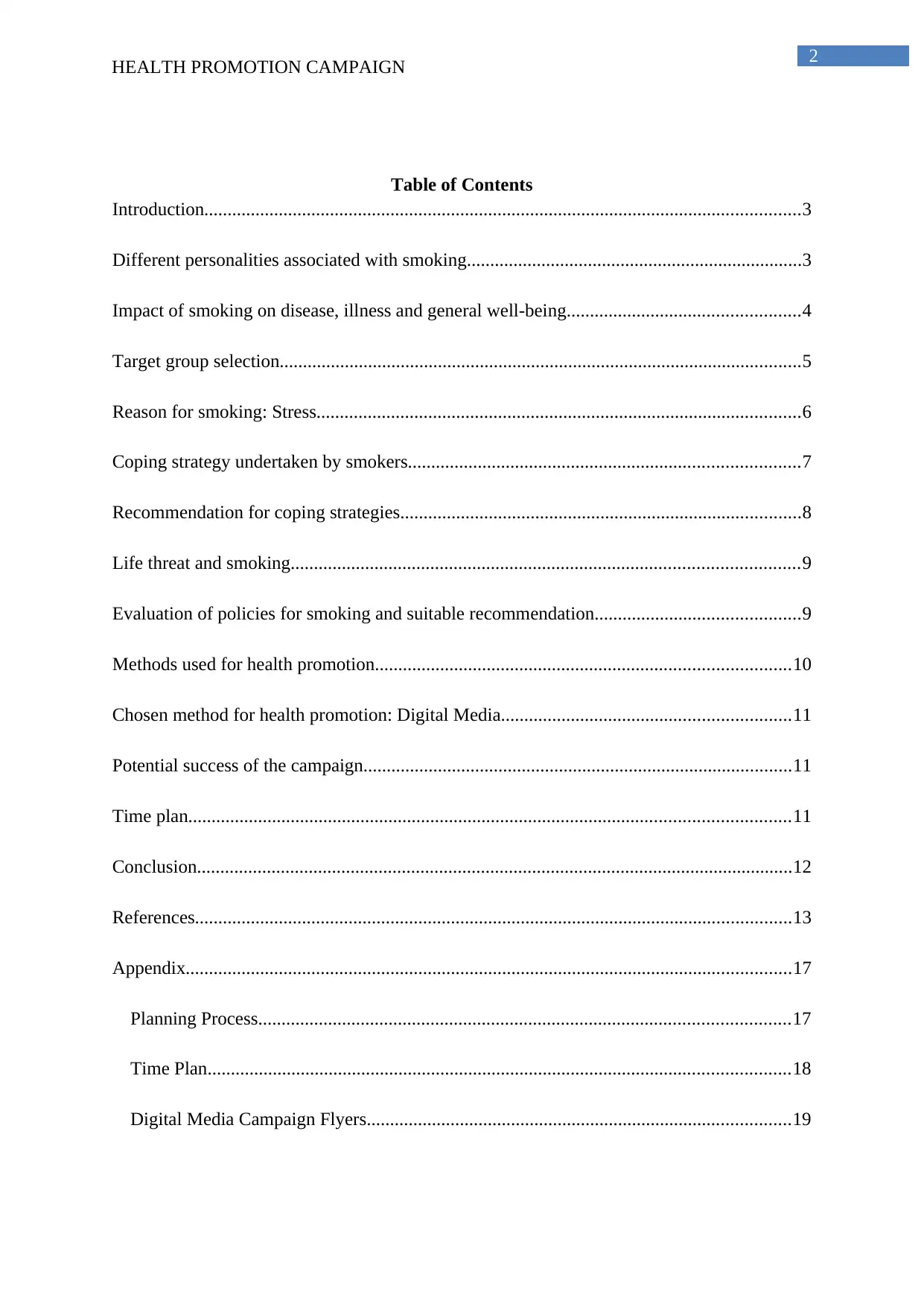
2
HEALTH PROMOTION CAMPAIGN
Table of Contents
Introduction................................................................................................................................3
Different personalities associated with smoking........................................................................3
Impact of smoking on disease, illness and general well-being..................................................4
Target group selection................................................................................................................5
Reason for smoking: Stress........................................................................................................6
Coping strategy undertaken by smokers....................................................................................7
Recommendation for coping strategies......................................................................................8
Life threat and smoking.............................................................................................................9
Evaluation of policies for smoking and suitable recommendation............................................9
Methods used for health promotion.........................................................................................10
Chosen method for health promotion: Digital Media..............................................................11
Potential success of the campaign............................................................................................11
Time plan.................................................................................................................................11
Conclusion................................................................................................................................12
References................................................................................................................................13
Appendix..................................................................................................................................17
Planning Process..................................................................................................................17
Time Plan.............................................................................................................................18
Digital Media Campaign Flyers...........................................................................................19
HEALTH PROMOTION CAMPAIGN
Table of Contents
Introduction................................................................................................................................3
Different personalities associated with smoking........................................................................3
Impact of smoking on disease, illness and general well-being..................................................4
Target group selection................................................................................................................5
Reason for smoking: Stress........................................................................................................6
Coping strategy undertaken by smokers....................................................................................7
Recommendation for coping strategies......................................................................................8
Life threat and smoking.............................................................................................................9
Evaluation of policies for smoking and suitable recommendation............................................9
Methods used for health promotion.........................................................................................10
Chosen method for health promotion: Digital Media..............................................................11
Potential success of the campaign............................................................................................11
Time plan.................................................................................................................................11
Conclusion................................................................................................................................12
References................................................................................................................................13
Appendix..................................................................................................................................17
Planning Process..................................................................................................................17
Time Plan.............................................................................................................................18
Digital Media Campaign Flyers...........................................................................................19
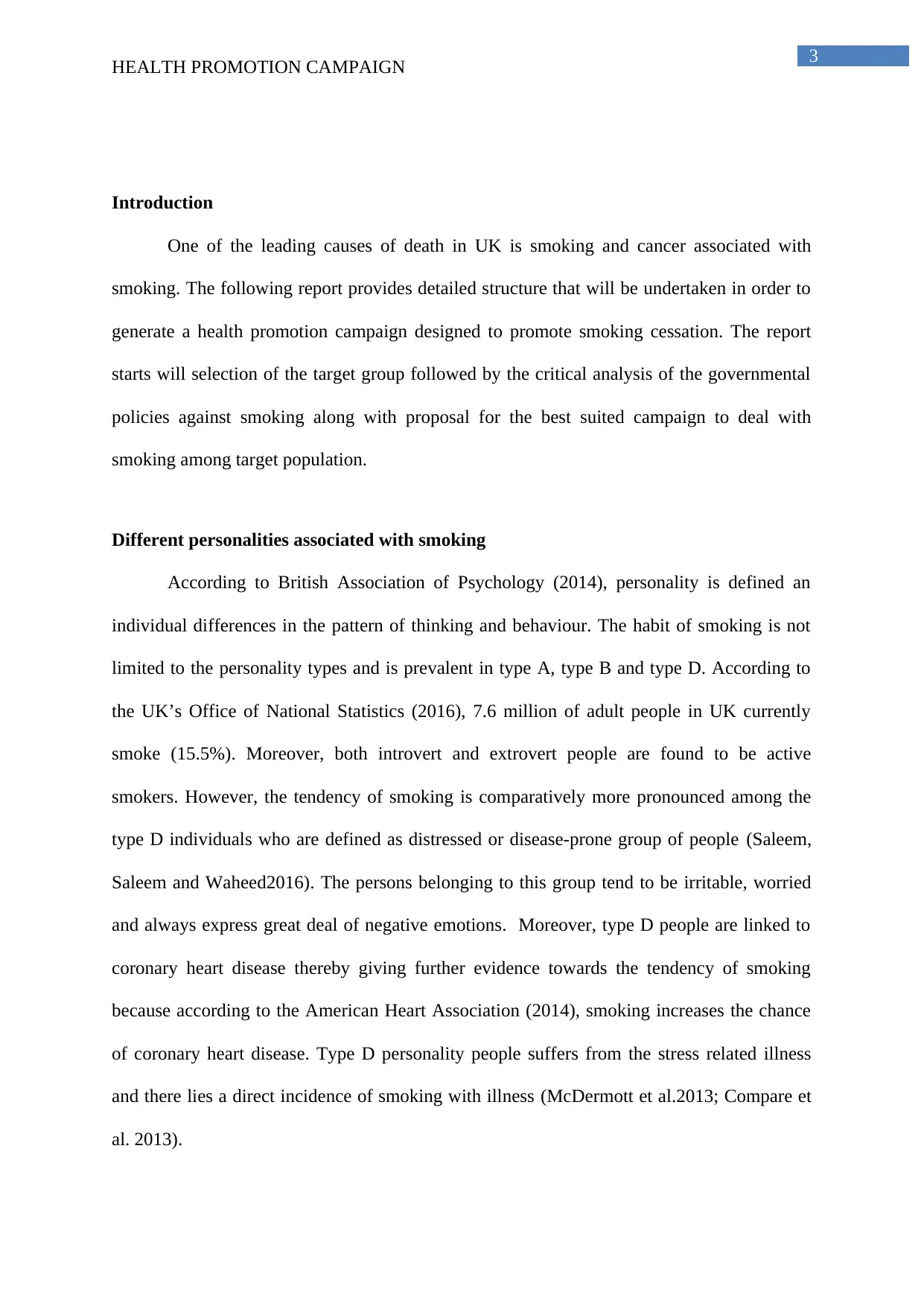
3
HEALTH PROMOTION CAMPAIGN
Introduction
One of the leading causes of death in UK is smoking and cancer associated with
smoking. The following report provides detailed structure that will be undertaken in order to
generate a health promotion campaign designed to promote smoking cessation. The report
starts will selection of the target group followed by the critical analysis of the governmental
policies against smoking along with proposal for the best suited campaign to deal with
smoking among target population.
Different personalities associated with smoking
According to British Association of Psychology (2014), personality is defined an
individual differences in the pattern of thinking and behaviour. The habit of smoking is not
limited to the personality types and is prevalent in type A, type B and type D. According to
the UK’s Office of National Statistics (2016), 7.6 million of adult people in UK currently
smoke (15.5%). Moreover, both introvert and extrovert people are found to be active
smokers. However, the tendency of smoking is comparatively more pronounced among the
type D individuals who are defined as distressed or disease-prone group of people (Saleem,
Saleem and Waheed2016). The persons belonging to this group tend to be irritable, worried
and always express great deal of negative emotions. Moreover, type D people are linked to
coronary heart disease thereby giving further evidence towards the tendency of smoking
because according to the American Heart Association (2014), smoking increases the chance
of coronary heart disease. Type D personality people suffers from the stress related illness
and there lies a direct incidence of smoking with illness (McDermott et al.2013; Compare et
al. 2013).
HEALTH PROMOTION CAMPAIGN
Introduction
One of the leading causes of death in UK is smoking and cancer associated with
smoking. The following report provides detailed structure that will be undertaken in order to
generate a health promotion campaign designed to promote smoking cessation. The report
starts will selection of the target group followed by the critical analysis of the governmental
policies against smoking along with proposal for the best suited campaign to deal with
smoking among target population.
Different personalities associated with smoking
According to British Association of Psychology (2014), personality is defined an
individual differences in the pattern of thinking and behaviour. The habit of smoking is not
limited to the personality types and is prevalent in type A, type B and type D. According to
the UK’s Office of National Statistics (2016), 7.6 million of adult people in UK currently
smoke (15.5%). Moreover, both introvert and extrovert people are found to be active
smokers. However, the tendency of smoking is comparatively more pronounced among the
type D individuals who are defined as distressed or disease-prone group of people (Saleem,
Saleem and Waheed2016). The persons belonging to this group tend to be irritable, worried
and always express great deal of negative emotions. Moreover, type D people are linked to
coronary heart disease thereby giving further evidence towards the tendency of smoking
because according to the American Heart Association (2014), smoking increases the chance
of coronary heart disease. Type D personality people suffers from the stress related illness
and there lies a direct incidence of smoking with illness (McDermott et al.2013; Compare et
al. 2013).
Secure Best Marks with AI Grader
Need help grading? Try our AI Grader for instant feedback on your assignments.
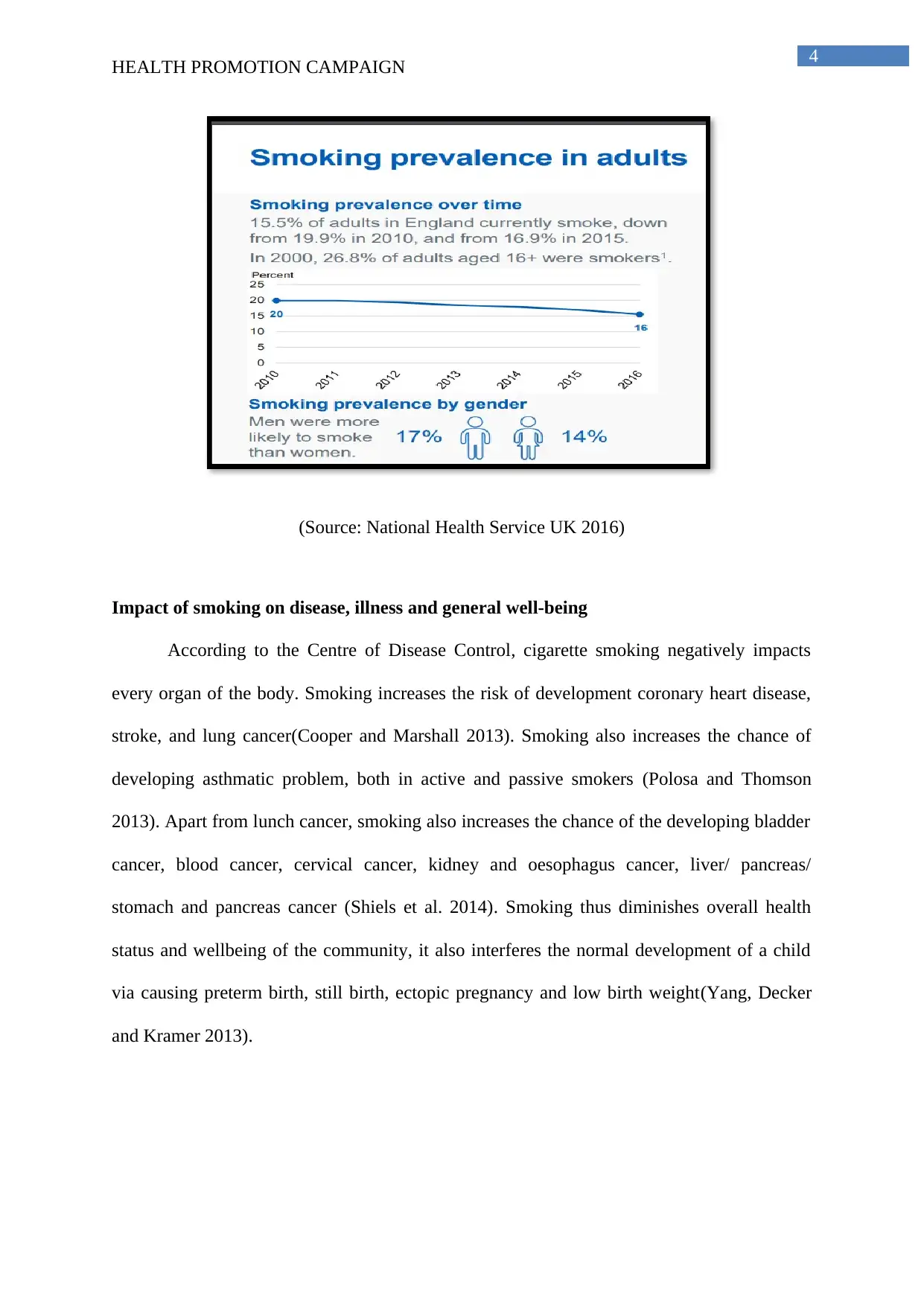
4
HEALTH PROMOTION CAMPAIGN
(Source: National Health Service UK 2016)
Impact of smoking on disease, illness and general well-being
According to the Centre of Disease Control, cigarette smoking negatively impacts
every organ of the body. Smoking increases the risk of development coronary heart disease,
stroke, and lung cancer(Cooper and Marshall 2013). Smoking also increases the chance of
developing asthmatic problem, both in active and passive smokers (Polosa and Thomson
2013). Apart from lunch cancer, smoking also increases the chance of the developing bladder
cancer, blood cancer, cervical cancer, kidney and oesophagus cancer, liver/ pancreas/
stomach and pancreas cancer (Shiels et al. 2014). Smoking thus diminishes overall health
status and wellbeing of the community, it also interferes the normal development of a child
via causing preterm birth, still birth, ectopic pregnancy and low birth weight(Yang, Decker
and Kramer 2013).
HEALTH PROMOTION CAMPAIGN
(Source: National Health Service UK 2016)
Impact of smoking on disease, illness and general well-being
According to the Centre of Disease Control, cigarette smoking negatively impacts
every organ of the body. Smoking increases the risk of development coronary heart disease,
stroke, and lung cancer(Cooper and Marshall 2013). Smoking also increases the chance of
developing asthmatic problem, both in active and passive smokers (Polosa and Thomson
2013). Apart from lunch cancer, smoking also increases the chance of the developing bladder
cancer, blood cancer, cervical cancer, kidney and oesophagus cancer, liver/ pancreas/
stomach and pancreas cancer (Shiels et al. 2014). Smoking thus diminishes overall health
status and wellbeing of the community, it also interferes the normal development of a child
via causing preterm birth, still birth, ectopic pregnancy and low birth weight(Yang, Decker
and Kramer 2013).
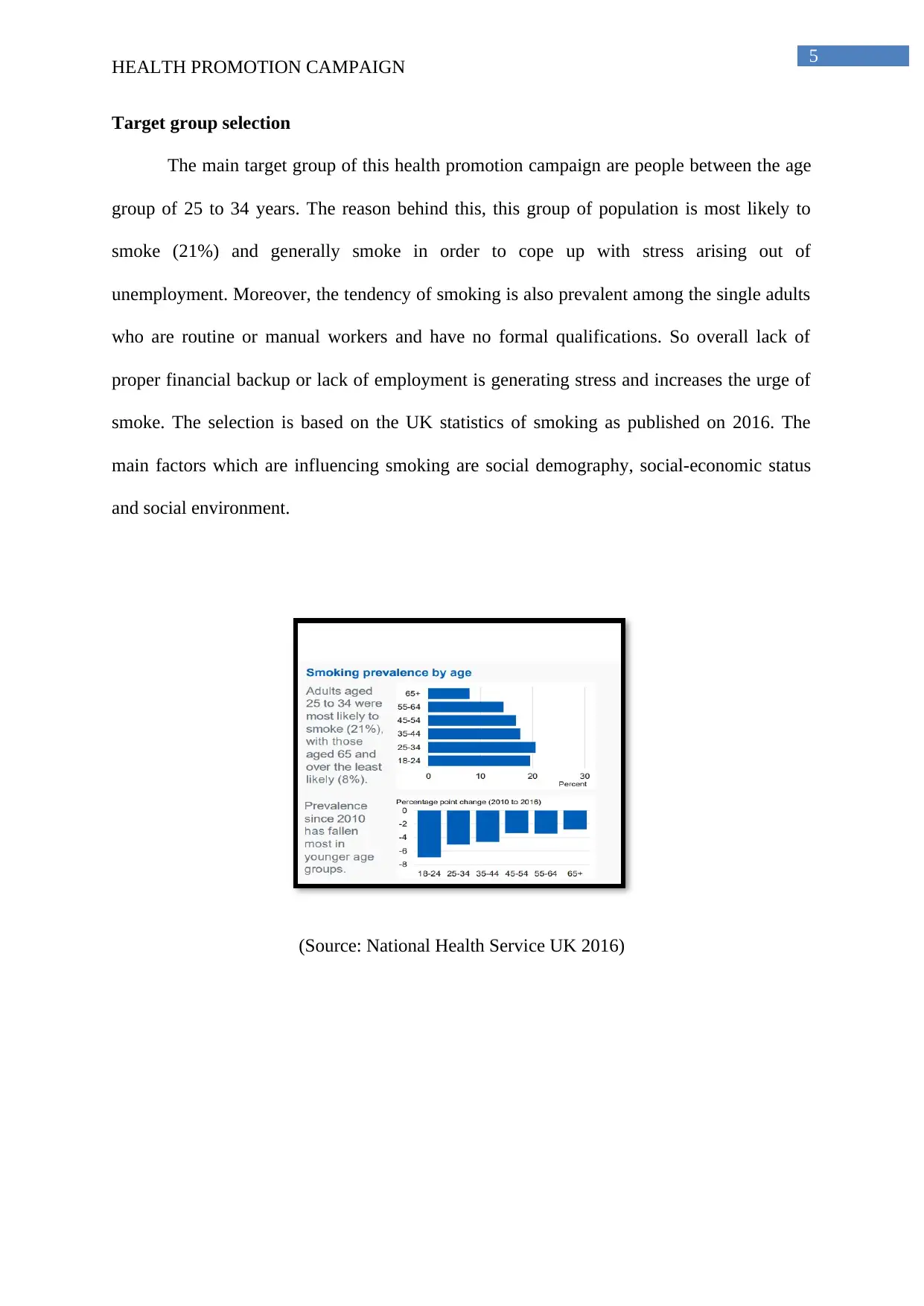
5
HEALTH PROMOTION CAMPAIGN
Target group selection
The main target group of this health promotion campaign are people between the age
group of 25 to 34 years. The reason behind this, this group of population is most likely to
smoke (21%) and generally smoke in order to cope up with stress arising out of
unemployment. Moreover, the tendency of smoking is also prevalent among the single adults
who are routine or manual workers and have no formal qualifications. So overall lack of
proper financial backup or lack of employment is generating stress and increases the urge of
smoke. The selection is based on the UK statistics of smoking as published on 2016. The
main factors which are influencing smoking are social demography, social-economic status
and social environment.
(Source: National Health Service UK 2016)
HEALTH PROMOTION CAMPAIGN
Target group selection
The main target group of this health promotion campaign are people between the age
group of 25 to 34 years. The reason behind this, this group of population is most likely to
smoke (21%) and generally smoke in order to cope up with stress arising out of
unemployment. Moreover, the tendency of smoking is also prevalent among the single adults
who are routine or manual workers and have no formal qualifications. So overall lack of
proper financial backup or lack of employment is generating stress and increases the urge of
smoke. The selection is based on the UK statistics of smoking as published on 2016. The
main factors which are influencing smoking are social demography, social-economic status
and social environment.
(Source: National Health Service UK 2016)

6
HEALTH PROMOTION CAMPAIGN
(Source: National Health Service UK 2016)
(Source: National Health Service UK 2016)
Reason for smoking: Stress
The main reason behind smoking is coping with stress. In biological or medical
context, stress is regarded as mental, physical or emotional factor that causes mental tension.
Stress can be both external and internal (Folkman2013). In case of stress associated with
smoking, external factors are mainly significant like environment, psychological or social
HEALTH PROMOTION CAMPAIGN
(Source: National Health Service UK 2016)
(Source: National Health Service UK 2016)
Reason for smoking: Stress
The main reason behind smoking is coping with stress. In biological or medical
context, stress is regarded as mental, physical or emotional factor that causes mental tension.
Stress can be both external and internal (Folkman2013). In case of stress associated with
smoking, external factors are mainly significant like environment, psychological or social
Paraphrase This Document
Need a fresh take? Get an instant paraphrase of this document with our AI Paraphraser
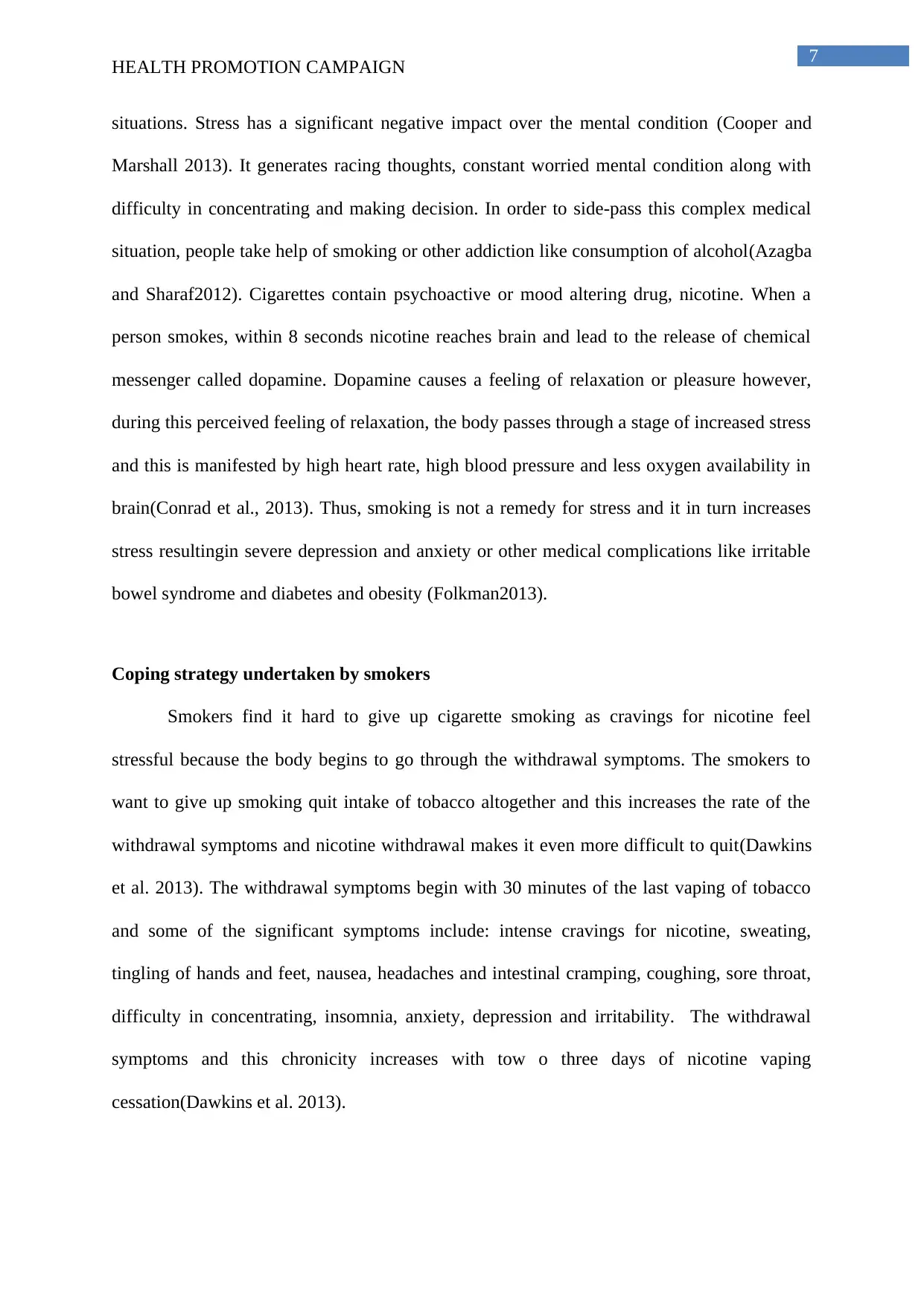
7
HEALTH PROMOTION CAMPAIGN
situations. Stress has a significant negative impact over the mental condition (Cooper and
Marshall 2013). It generates racing thoughts, constant worried mental condition along with
difficulty in concentrating and making decision. In order to side-pass this complex medical
situation, people take help of smoking or other addiction like consumption of alcohol(Azagba
and Sharaf2012). Cigarettes contain psychoactive or mood altering drug, nicotine. When a
person smokes, within 8 seconds nicotine reaches brain and lead to the release of chemical
messenger called dopamine. Dopamine causes a feeling of relaxation or pleasure however,
during this perceived feeling of relaxation, the body passes through a stage of increased stress
and this is manifested by high heart rate, high blood pressure and less oxygen availability in
brain(Conrad et al., 2013). Thus, smoking is not a remedy for stress and it in turn increases
stress resultingin severe depression and anxiety or other medical complications like irritable
bowel syndrome and diabetes and obesity (Folkman2013).
Coping strategy undertaken by smokers
Smokers find it hard to give up cigarette smoking as cravings for nicotine feel
stressful because the body begins to go through the withdrawal symptoms. The smokers to
want to give up smoking quit intake of tobacco altogether and this increases the rate of the
withdrawal symptoms and nicotine withdrawal makes it even more difficult to quit(Dawkins
et al. 2013). The withdrawal symptoms begin with 30 minutes of the last vaping of tobacco
and some of the significant symptoms include: intense cravings for nicotine, sweating,
tingling of hands and feet, nausea, headaches and intestinal cramping, coughing, sore throat,
difficulty in concentrating, insomnia, anxiety, depression and irritability. The withdrawal
symptoms and this chronicity increases with tow o three days of nicotine vaping
cessation(Dawkins et al. 2013).
HEALTH PROMOTION CAMPAIGN
situations. Stress has a significant negative impact over the mental condition (Cooper and
Marshall 2013). It generates racing thoughts, constant worried mental condition along with
difficulty in concentrating and making decision. In order to side-pass this complex medical
situation, people take help of smoking or other addiction like consumption of alcohol(Azagba
and Sharaf2012). Cigarettes contain psychoactive or mood altering drug, nicotine. When a
person smokes, within 8 seconds nicotine reaches brain and lead to the release of chemical
messenger called dopamine. Dopamine causes a feeling of relaxation or pleasure however,
during this perceived feeling of relaxation, the body passes through a stage of increased stress
and this is manifested by high heart rate, high blood pressure and less oxygen availability in
brain(Conrad et al., 2013). Thus, smoking is not a remedy for stress and it in turn increases
stress resultingin severe depression and anxiety or other medical complications like irritable
bowel syndrome and diabetes and obesity (Folkman2013).
Coping strategy undertaken by smokers
Smokers find it hard to give up cigarette smoking as cravings for nicotine feel
stressful because the body begins to go through the withdrawal symptoms. The smokers to
want to give up smoking quit intake of tobacco altogether and this increases the rate of the
withdrawal symptoms and nicotine withdrawal makes it even more difficult to quit(Dawkins
et al. 2013). The withdrawal symptoms begin with 30 minutes of the last vaping of tobacco
and some of the significant symptoms include: intense cravings for nicotine, sweating,
tingling of hands and feet, nausea, headaches and intestinal cramping, coughing, sore throat,
difficulty in concentrating, insomnia, anxiety, depression and irritability. The withdrawal
symptoms and this chronicity increases with tow o three days of nicotine vaping
cessation(Dawkins et al. 2013).
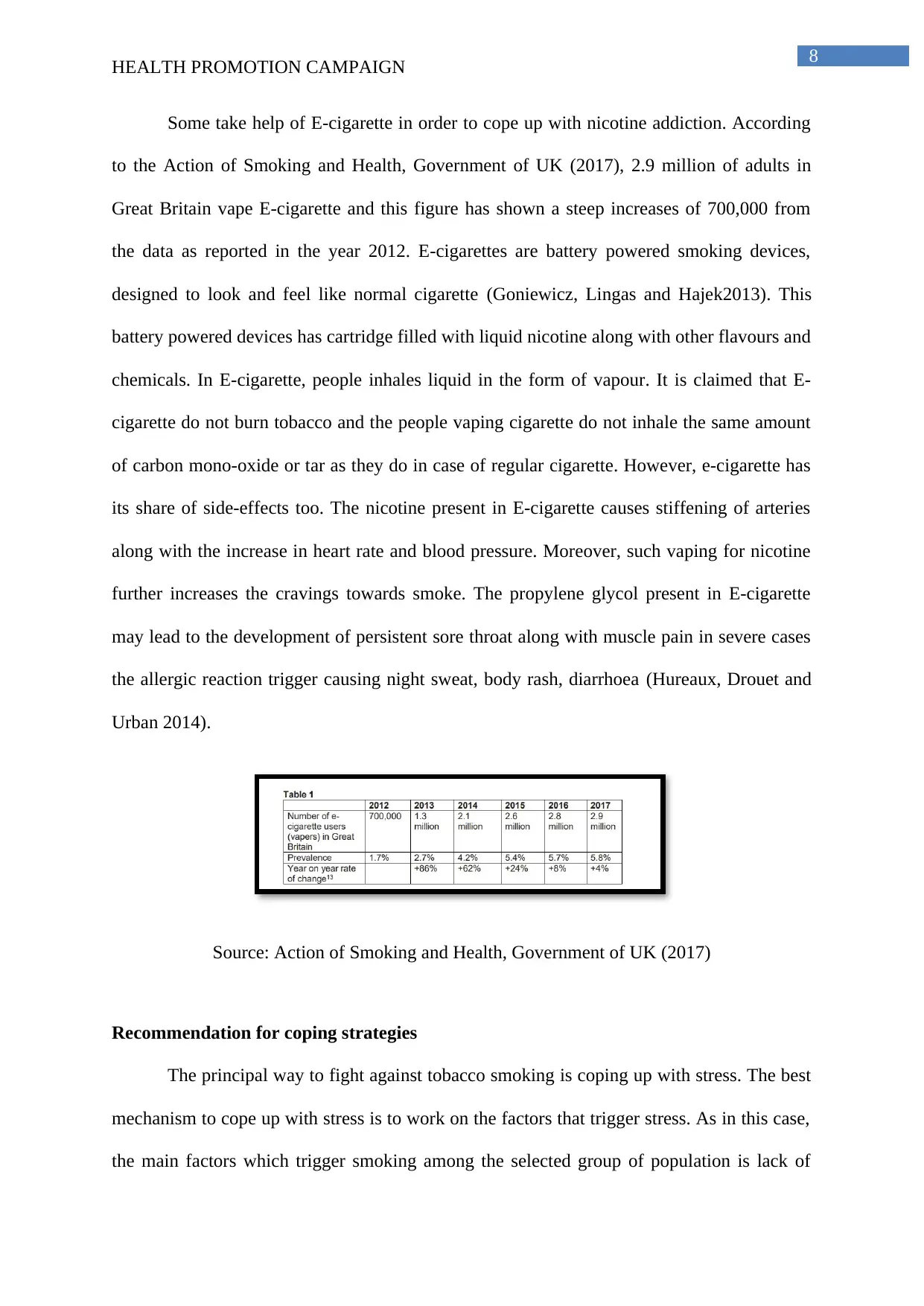
8
HEALTH PROMOTION CAMPAIGN
Some take help of E-cigarette in order to cope up with nicotine addiction. According
to the Action of Smoking and Health, Government of UK (2017), 2.9 million of adults in
Great Britain vape E-cigarette and this figure has shown a steep increases of 700,000 from
the data as reported in the year 2012. E-cigarettes are battery powered smoking devices,
designed to look and feel like normal cigarette (Goniewicz, Lingas and Hajek2013). This
battery powered devices has cartridge filled with liquid nicotine along with other flavours and
chemicals. In E-cigarette, people inhales liquid in the form of vapour. It is claimed that E-
cigarette do not burn tobacco and the people vaping cigarette do not inhale the same amount
of carbon mono-oxide or tar as they do in case of regular cigarette. However, e-cigarette has
its share of side-effects too. The nicotine present in E-cigarette causes stiffening of arteries
along with the increase in heart rate and blood pressure. Moreover, such vaping for nicotine
further increases the cravings towards smoke. The propylene glycol present in E-cigarette
may lead to the development of persistent sore throat along with muscle pain in severe cases
the allergic reaction trigger causing night sweat, body rash, diarrhoea (Hureaux, Drouet and
Urban 2014).
Source: Action of Smoking and Health, Government of UK (2017)
Recommendation for coping strategies
The principal way to fight against tobacco smoking is coping up with stress. The best
mechanism to cope up with stress is to work on the factors that trigger stress. As in this case,
the main factors which trigger smoking among the selected group of population is lack of
HEALTH PROMOTION CAMPAIGN
Some take help of E-cigarette in order to cope up with nicotine addiction. According
to the Action of Smoking and Health, Government of UK (2017), 2.9 million of adults in
Great Britain vape E-cigarette and this figure has shown a steep increases of 700,000 from
the data as reported in the year 2012. E-cigarettes are battery powered smoking devices,
designed to look and feel like normal cigarette (Goniewicz, Lingas and Hajek2013). This
battery powered devices has cartridge filled with liquid nicotine along with other flavours and
chemicals. In E-cigarette, people inhales liquid in the form of vapour. It is claimed that E-
cigarette do not burn tobacco and the people vaping cigarette do not inhale the same amount
of carbon mono-oxide or tar as they do in case of regular cigarette. However, e-cigarette has
its share of side-effects too. The nicotine present in E-cigarette causes stiffening of arteries
along with the increase in heart rate and blood pressure. Moreover, such vaping for nicotine
further increases the cravings towards smoke. The propylene glycol present in E-cigarette
may lead to the development of persistent sore throat along with muscle pain in severe cases
the allergic reaction trigger causing night sweat, body rash, diarrhoea (Hureaux, Drouet and
Urban 2014).
Source: Action of Smoking and Health, Government of UK (2017)
Recommendation for coping strategies
The principal way to fight against tobacco smoking is coping up with stress. The best
mechanism to cope up with stress is to work on the factors that trigger stress. As in this case,
the main factors which trigger smoking among the selected group of population is lack of
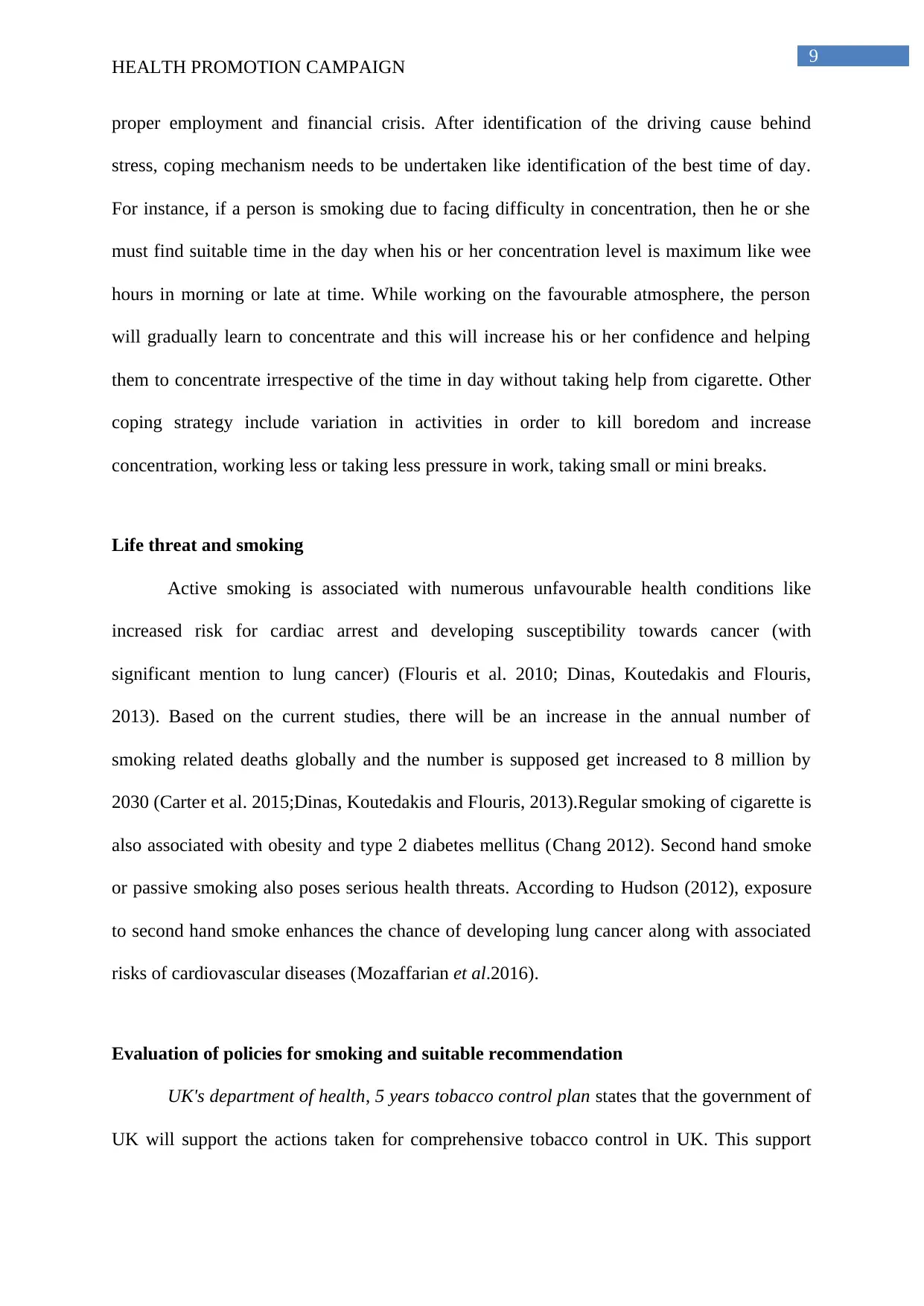
9
HEALTH PROMOTION CAMPAIGN
proper employment and financial crisis. After identification of the driving cause behind
stress, coping mechanism needs to be undertaken like identification of the best time of day.
For instance, if a person is smoking due to facing difficulty in concentration, then he or she
must find suitable time in the day when his or her concentration level is maximum like wee
hours in morning or late at time. While working on the favourable atmosphere, the person
will gradually learn to concentrate and this will increase his or her confidence and helping
them to concentrate irrespective of the time in day without taking help from cigarette. Other
coping strategy include variation in activities in order to kill boredom and increase
concentration, working less or taking less pressure in work, taking small or mini breaks.
Life threat and smoking
Active smoking is associated with numerous unfavourable health conditions like
increased risk for cardiac arrest and developing susceptibility towards cancer (with
significant mention to lung cancer) (Flouris et al. 2010; Dinas, Koutedakis and Flouris,
2013). Based on the current studies, there will be an increase in the annual number of
smoking related deaths globally and the number is supposed get increased to 8 million by
2030 (Carter et al. 2015;Dinas, Koutedakis and Flouris, 2013).Regular smoking of cigarette is
also associated with obesity and type 2 diabetes mellitus (Chang 2012). Second hand smoke
or passive smoking also poses serious health threats. According to Hudson (2012), exposure
to second hand smoke enhances the chance of developing lung cancer along with associated
risks of cardiovascular diseases (Mozaffarian et al.2016).
Evaluation of policies for smoking and suitable recommendation
UK's department of health, 5 years tobacco control plan states that the government of
UK will support the actions taken for comprehensive tobacco control in UK. This support
HEALTH PROMOTION CAMPAIGN
proper employment and financial crisis. After identification of the driving cause behind
stress, coping mechanism needs to be undertaken like identification of the best time of day.
For instance, if a person is smoking due to facing difficulty in concentration, then he or she
must find suitable time in the day when his or her concentration level is maximum like wee
hours in morning or late at time. While working on the favourable atmosphere, the person
will gradually learn to concentrate and this will increase his or her confidence and helping
them to concentrate irrespective of the time in day without taking help from cigarette. Other
coping strategy include variation in activities in order to kill boredom and increase
concentration, working less or taking less pressure in work, taking small or mini breaks.
Life threat and smoking
Active smoking is associated with numerous unfavourable health conditions like
increased risk for cardiac arrest and developing susceptibility towards cancer (with
significant mention to lung cancer) (Flouris et al. 2010; Dinas, Koutedakis and Flouris,
2013). Based on the current studies, there will be an increase in the annual number of
smoking related deaths globally and the number is supposed get increased to 8 million by
2030 (Carter et al. 2015;Dinas, Koutedakis and Flouris, 2013).Regular smoking of cigarette is
also associated with obesity and type 2 diabetes mellitus (Chang 2012). Second hand smoke
or passive smoking also poses serious health threats. According to Hudson (2012), exposure
to second hand smoke enhances the chance of developing lung cancer along with associated
risks of cardiovascular diseases (Mozaffarian et al.2016).
Evaluation of policies for smoking and suitable recommendation
UK's department of health, 5 years tobacco control plan states that the government of
UK will support the actions taken for comprehensive tobacco control in UK. This support
Secure Best Marks with AI Grader
Need help grading? Try our AI Grader for instant feedback on your assignments.
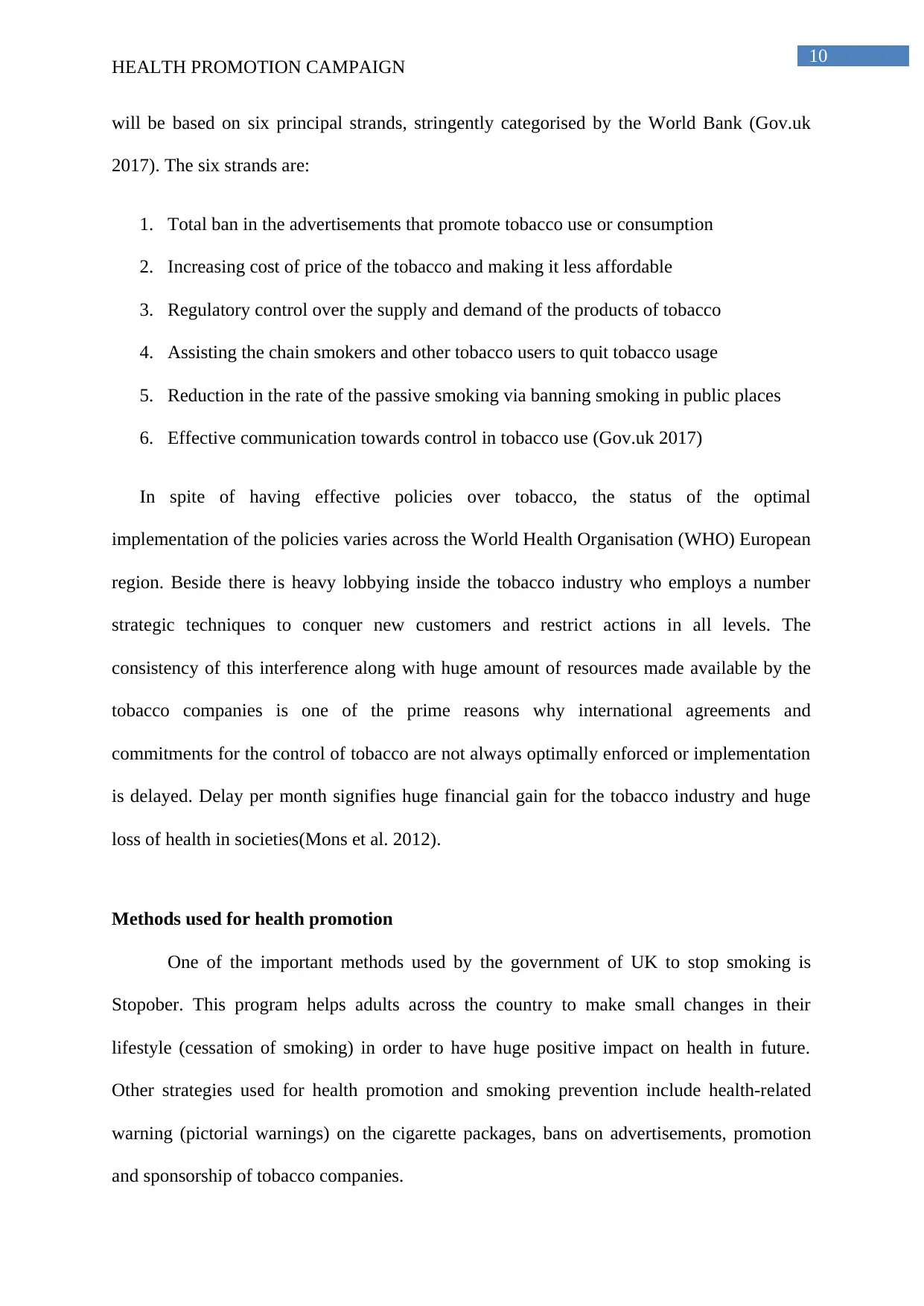
10
HEALTH PROMOTION CAMPAIGN
will be based on six principal strands, stringently categorised by the World Bank (Gov.uk
2017). The six strands are:
1. Total ban in the advertisements that promote tobacco use or consumption
2. Increasing cost of price of the tobacco and making it less affordable
3. Regulatory control over the supply and demand of the products of tobacco
4. Assisting the chain smokers and other tobacco users to quit tobacco usage
5. Reduction in the rate of the passive smoking via banning smoking in public places
6. Effective communication towards control in tobacco use (Gov.uk 2017)
In spite of having effective policies over tobacco, the status of the optimal
implementation of the policies varies across the World Health Organisation (WHO) European
region. Beside there is heavy lobbying inside the tobacco industry who employs a number
strategic techniques to conquer new customers and restrict actions in all levels. The
consistency of this interference along with huge amount of resources made available by the
tobacco companies is one of the prime reasons why international agreements and
commitments for the control of tobacco are not always optimally enforced or implementation
is delayed. Delay per month signifies huge financial gain for the tobacco industry and huge
loss of health in societies(Mons et al. 2012).
Methods used for health promotion
One of the important methods used by the government of UK to stop smoking is
Stopober. This program helps adults across the country to make small changes in their
lifestyle (cessation of smoking) in order to have huge positive impact on health in future.
Other strategies used for health promotion and smoking prevention include health-related
warning (pictorial warnings) on the cigarette packages, bans on advertisements, promotion
and sponsorship of tobacco companies.
HEALTH PROMOTION CAMPAIGN
will be based on six principal strands, stringently categorised by the World Bank (Gov.uk
2017). The six strands are:
1. Total ban in the advertisements that promote tobacco use or consumption
2. Increasing cost of price of the tobacco and making it less affordable
3. Regulatory control over the supply and demand of the products of tobacco
4. Assisting the chain smokers and other tobacco users to quit tobacco usage
5. Reduction in the rate of the passive smoking via banning smoking in public places
6. Effective communication towards control in tobacco use (Gov.uk 2017)
In spite of having effective policies over tobacco, the status of the optimal
implementation of the policies varies across the World Health Organisation (WHO) European
region. Beside there is heavy lobbying inside the tobacco industry who employs a number
strategic techniques to conquer new customers and restrict actions in all levels. The
consistency of this interference along with huge amount of resources made available by the
tobacco companies is one of the prime reasons why international agreements and
commitments for the control of tobacco are not always optimally enforced or implementation
is delayed. Delay per month signifies huge financial gain for the tobacco industry and huge
loss of health in societies(Mons et al. 2012).
Methods used for health promotion
One of the important methods used by the government of UK to stop smoking is
Stopober. This program helps adults across the country to make small changes in their
lifestyle (cessation of smoking) in order to have huge positive impact on health in future.
Other strategies used for health promotion and smoking prevention include health-related
warning (pictorial warnings) on the cigarette packages, bans on advertisements, promotion
and sponsorship of tobacco companies.
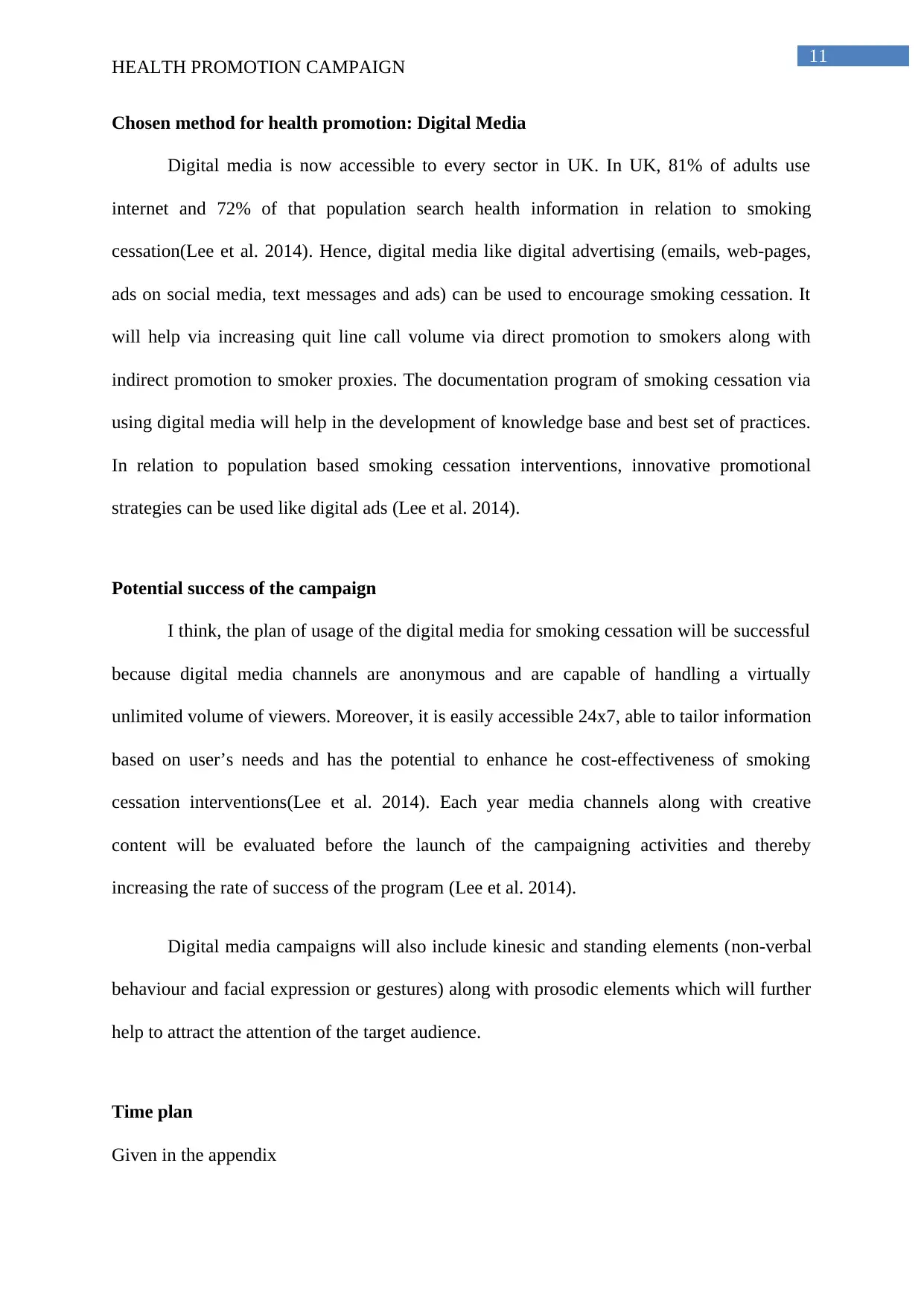
11
HEALTH PROMOTION CAMPAIGN
Chosen method for health promotion: Digital Media
Digital media is now accessible to every sector in UK. In UK, 81% of adults use
internet and 72% of that population search health information in relation to smoking
cessation(Lee et al. 2014). Hence, digital media like digital advertising (emails, web-pages,
ads on social media, text messages and ads) can be used to encourage smoking cessation. It
will help via increasing quit line call volume via direct promotion to smokers along with
indirect promotion to smoker proxies. The documentation program of smoking cessation via
using digital media will help in the development of knowledge base and best set of practices.
In relation to population based smoking cessation interventions, innovative promotional
strategies can be used like digital ads (Lee et al. 2014).
Potential success of the campaign
I think, the plan of usage of the digital media for smoking cessation will be successful
because digital media channels are anonymous and are capable of handling a virtually
unlimited volume of viewers. Moreover, it is easily accessible 24x7, able to tailor information
based on user’s needs and has the potential to enhance he cost-effectiveness of smoking
cessation interventions(Lee et al. 2014). Each year media channels along with creative
content will be evaluated before the launch of the campaigning activities and thereby
increasing the rate of success of the program (Lee et al. 2014).
Digital media campaigns will also include kinesic and standing elements (non-verbal
behaviour and facial expression or gestures) along with prosodic elements which will further
help to attract the attention of the target audience.
Time plan
Given in the appendix
HEALTH PROMOTION CAMPAIGN
Chosen method for health promotion: Digital Media
Digital media is now accessible to every sector in UK. In UK, 81% of adults use
internet and 72% of that population search health information in relation to smoking
cessation(Lee et al. 2014). Hence, digital media like digital advertising (emails, web-pages,
ads on social media, text messages and ads) can be used to encourage smoking cessation. It
will help via increasing quit line call volume via direct promotion to smokers along with
indirect promotion to smoker proxies. The documentation program of smoking cessation via
using digital media will help in the development of knowledge base and best set of practices.
In relation to population based smoking cessation interventions, innovative promotional
strategies can be used like digital ads (Lee et al. 2014).
Potential success of the campaign
I think, the plan of usage of the digital media for smoking cessation will be successful
because digital media channels are anonymous and are capable of handling a virtually
unlimited volume of viewers. Moreover, it is easily accessible 24x7, able to tailor information
based on user’s needs and has the potential to enhance he cost-effectiveness of smoking
cessation interventions(Lee et al. 2014). Each year media channels along with creative
content will be evaluated before the launch of the campaigning activities and thereby
increasing the rate of success of the program (Lee et al. 2014).
Digital media campaigns will also include kinesic and standing elements (non-verbal
behaviour and facial expression or gestures) along with prosodic elements which will further
help to attract the attention of the target audience.
Time plan
Given in the appendix
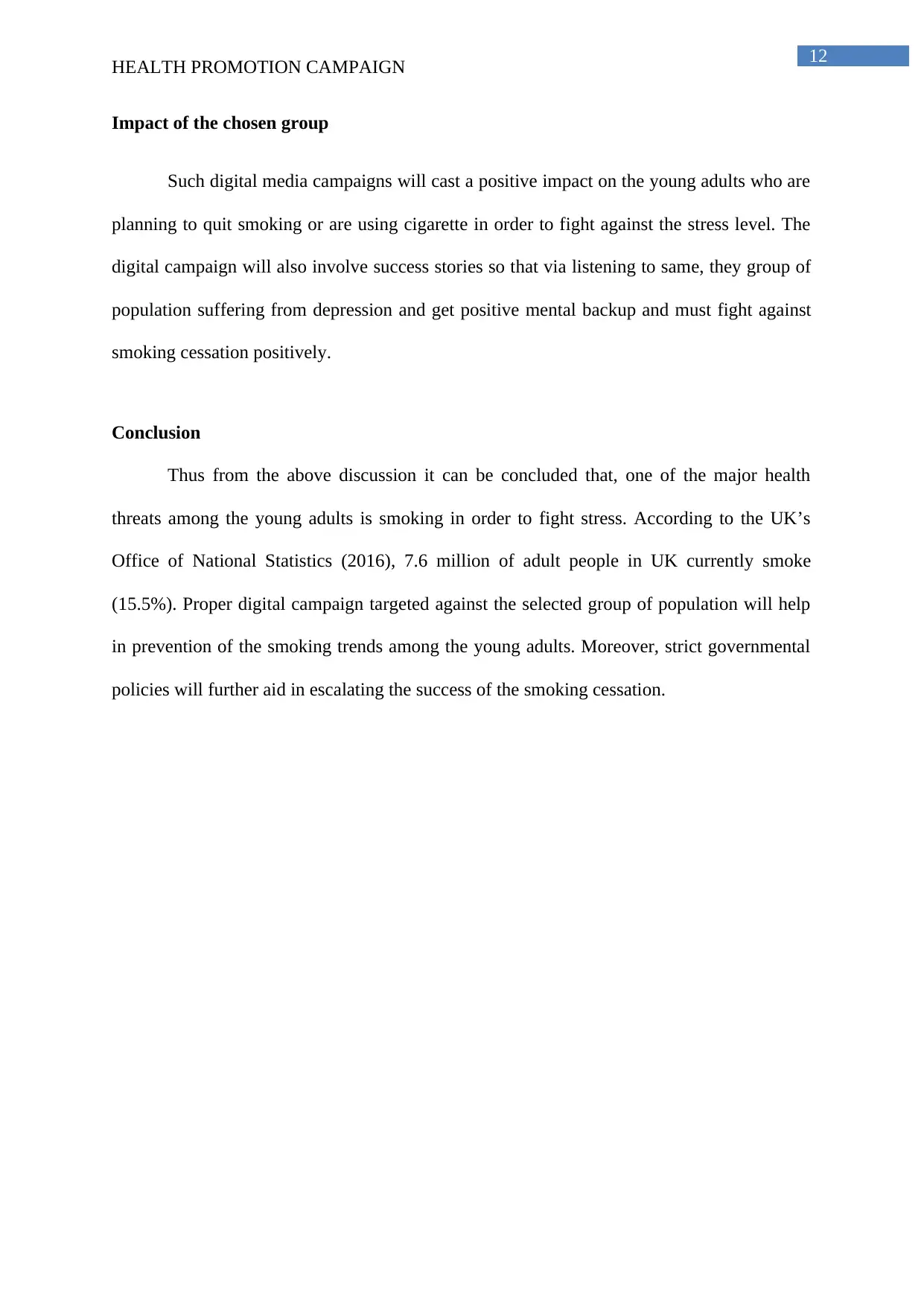
12
HEALTH PROMOTION CAMPAIGN
Impact of the chosen group
Such digital media campaigns will cast a positive impact on the young adults who are
planning to quit smoking or are using cigarette in order to fight against the stress level. The
digital campaign will also involve success stories so that via listening to same, they group of
population suffering from depression and get positive mental backup and must fight against
smoking cessation positively.
Conclusion
Thus from the above discussion it can be concluded that, one of the major health
threats among the young adults is smoking in order to fight stress. According to the UK’s
Office of National Statistics (2016), 7.6 million of adult people in UK currently smoke
(15.5%). Proper digital campaign targeted against the selected group of population will help
in prevention of the smoking trends among the young adults. Moreover, strict governmental
policies will further aid in escalating the success of the smoking cessation.
HEALTH PROMOTION CAMPAIGN
Impact of the chosen group
Such digital media campaigns will cast a positive impact on the young adults who are
planning to quit smoking or are using cigarette in order to fight against the stress level. The
digital campaign will also involve success stories so that via listening to same, they group of
population suffering from depression and get positive mental backup and must fight against
smoking cessation positively.
Conclusion
Thus from the above discussion it can be concluded that, one of the major health
threats among the young adults is smoking in order to fight stress. According to the UK’s
Office of National Statistics (2016), 7.6 million of adult people in UK currently smoke
(15.5%). Proper digital campaign targeted against the selected group of population will help
in prevention of the smoking trends among the young adults. Moreover, strict governmental
policies will further aid in escalating the success of the smoking cessation.
Paraphrase This Document
Need a fresh take? Get an instant paraphrase of this document with our AI Paraphraser
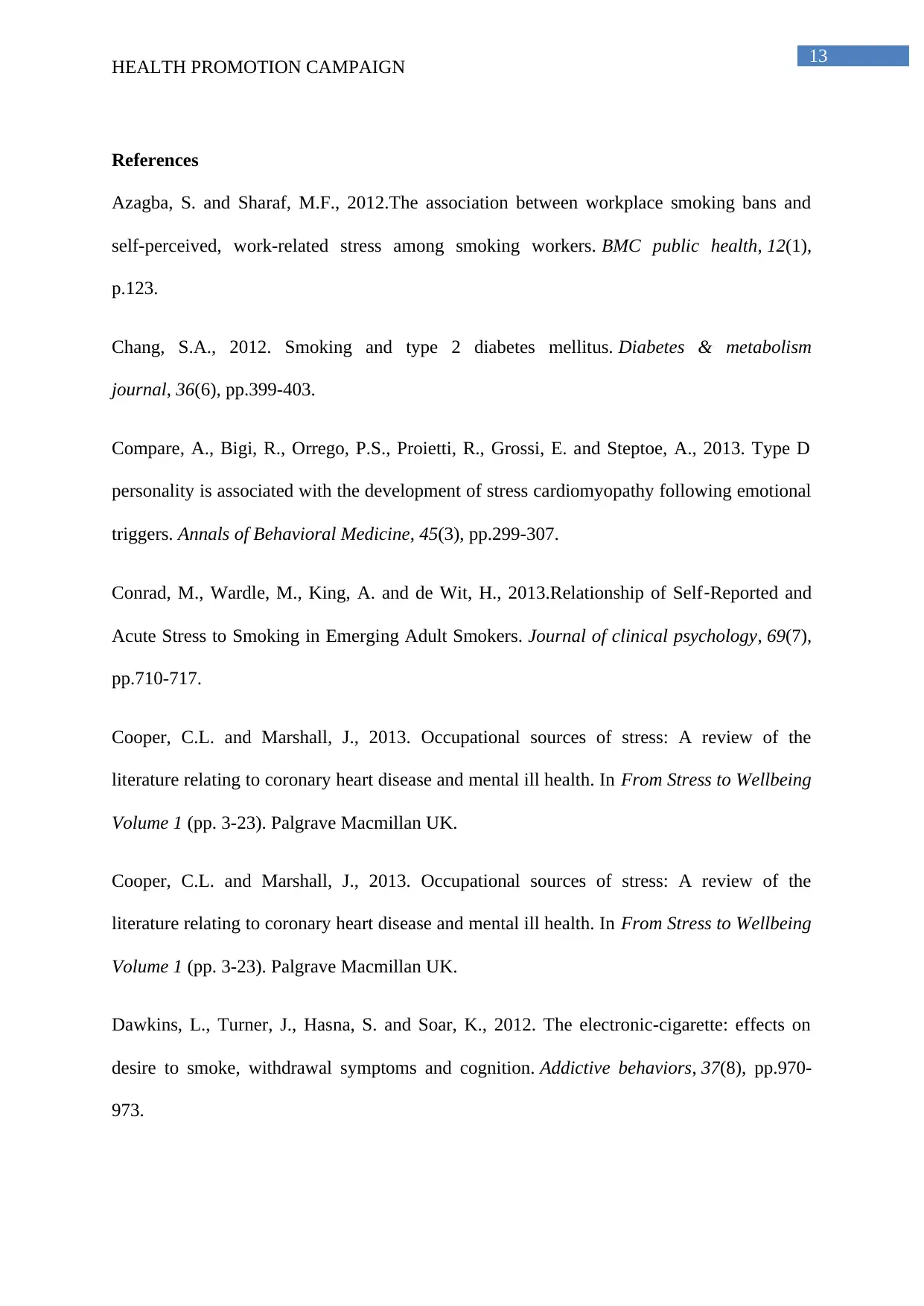
13
HEALTH PROMOTION CAMPAIGN
References
Azagba, S. and Sharaf, M.F., 2012.The association between workplace smoking bans and
self-perceived, work-related stress among smoking workers. BMC public health, 12(1),
p.123.
Chang, S.A., 2012. Smoking and type 2 diabetes mellitus. Diabetes & metabolism
journal, 36(6), pp.399-403.
Compare, A., Bigi, R., Orrego, P.S., Proietti, R., Grossi, E. and Steptoe, A., 2013. Type D
personality is associated with the development of stress cardiomyopathy following emotional
triggers. Annals of Behavioral Medicine, 45(3), pp.299-307.
Conrad, M., Wardle, M., King, A. and de Wit, H., 2013.Relationship of Self‐Reported and
Acute Stress to Smoking in Emerging Adult Smokers. Journal of clinical psychology, 69(7),
pp.710-717.
Cooper, C.L. and Marshall, J., 2013. Occupational sources of stress: A review of the
literature relating to coronary heart disease and mental ill health. In From Stress to Wellbeing
Volume 1 (pp. 3-23). Palgrave Macmillan UK.
Cooper, C.L. and Marshall, J., 2013. Occupational sources of stress: A review of the
literature relating to coronary heart disease and mental ill health. In From Stress to Wellbeing
Volume 1 (pp. 3-23). Palgrave Macmillan UK.
Dawkins, L., Turner, J., Hasna, S. and Soar, K., 2012. The electronic-cigarette: effects on
desire to smoke, withdrawal symptoms and cognition. Addictive behaviors, 37(8), pp.970-
973.
HEALTH PROMOTION CAMPAIGN
References
Azagba, S. and Sharaf, M.F., 2012.The association between workplace smoking bans and
self-perceived, work-related stress among smoking workers. BMC public health, 12(1),
p.123.
Chang, S.A., 2012. Smoking and type 2 diabetes mellitus. Diabetes & metabolism
journal, 36(6), pp.399-403.
Compare, A., Bigi, R., Orrego, P.S., Proietti, R., Grossi, E. and Steptoe, A., 2013. Type D
personality is associated with the development of stress cardiomyopathy following emotional
triggers. Annals of Behavioral Medicine, 45(3), pp.299-307.
Conrad, M., Wardle, M., King, A. and de Wit, H., 2013.Relationship of Self‐Reported and
Acute Stress to Smoking in Emerging Adult Smokers. Journal of clinical psychology, 69(7),
pp.710-717.
Cooper, C.L. and Marshall, J., 2013. Occupational sources of stress: A review of the
literature relating to coronary heart disease and mental ill health. In From Stress to Wellbeing
Volume 1 (pp. 3-23). Palgrave Macmillan UK.
Cooper, C.L. and Marshall, J., 2013. Occupational sources of stress: A review of the
literature relating to coronary heart disease and mental ill health. In From Stress to Wellbeing
Volume 1 (pp. 3-23). Palgrave Macmillan UK.
Dawkins, L., Turner, J., Hasna, S. and Soar, K., 2012. The electronic-cigarette: effects on
desire to smoke, withdrawal symptoms and cognition. Addictive behaviors, 37(8), pp.970-
973.
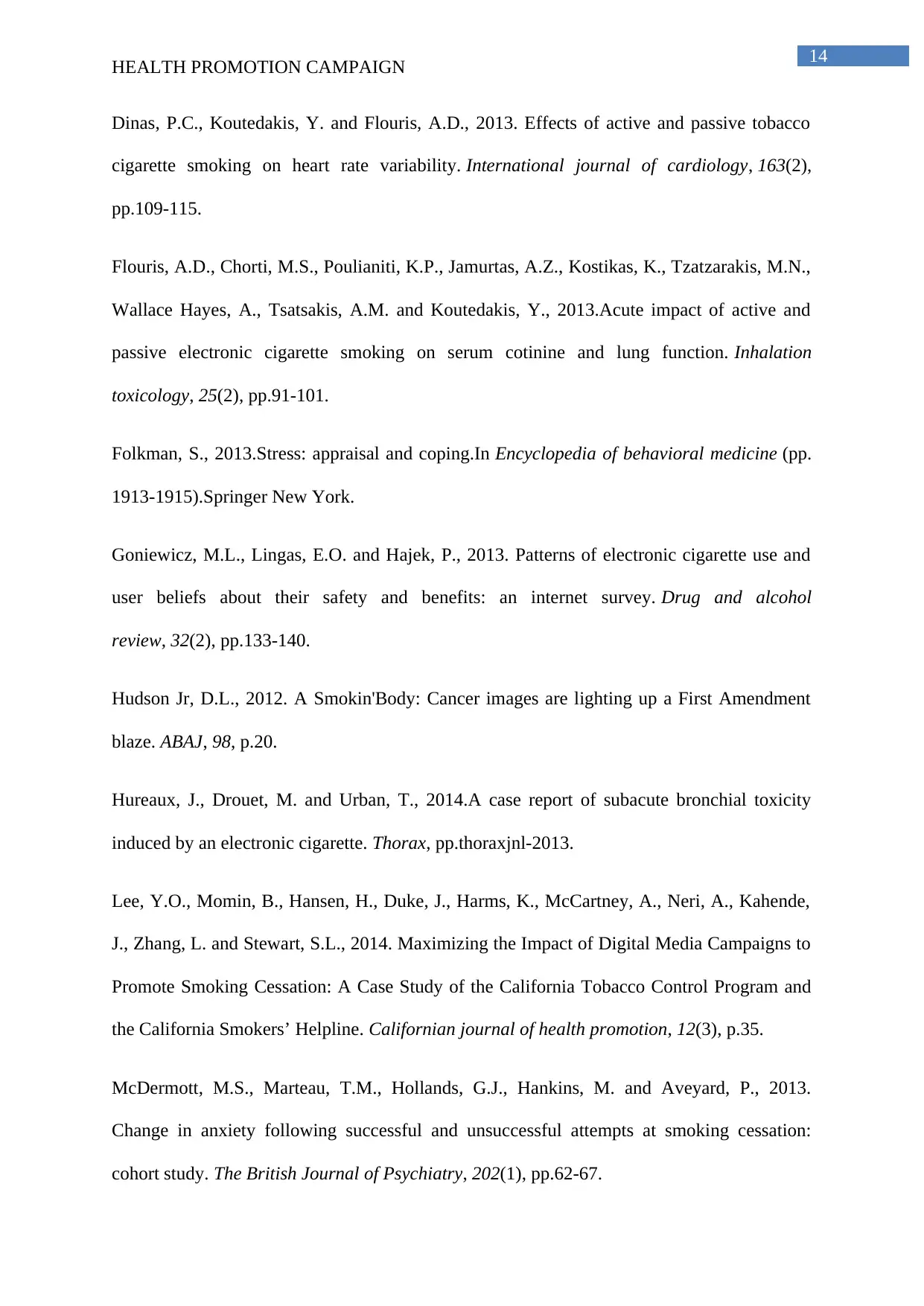
14
HEALTH PROMOTION CAMPAIGN
Dinas, P.C., Koutedakis, Y. and Flouris, A.D., 2013. Effects of active and passive tobacco
cigarette smoking on heart rate variability. International journal of cardiology, 163(2),
pp.109-115.
Flouris, A.D., Chorti, M.S., Poulianiti, K.P., Jamurtas, A.Z., Kostikas, K., Tzatzarakis, M.N.,
Wallace Hayes, A., Tsatsakis, A.M. and Koutedakis, Y., 2013.Acute impact of active and
passive electronic cigarette smoking on serum cotinine and lung function. Inhalation
toxicology, 25(2), pp.91-101.
Folkman, S., 2013.Stress: appraisal and coping.In Encyclopedia of behavioral medicine (pp.
1913-1915).Springer New York.
Goniewicz, M.L., Lingas, E.O. and Hajek, P., 2013. Patterns of electronic cigarette use and
user beliefs about their safety and benefits: an internet survey. Drug and alcohol
review, 32(2), pp.133-140.
Hudson Jr, D.L., 2012. A Smokin'Body: Cancer images are lighting up a First Amendment
blaze. ABAJ, 98, p.20.
Hureaux, J., Drouet, M. and Urban, T., 2014.A case report of subacute bronchial toxicity
induced by an electronic cigarette. Thorax, pp.thoraxjnl-2013.
Lee, Y.O., Momin, B., Hansen, H., Duke, J., Harms, K., McCartney, A., Neri, A., Kahende,
J., Zhang, L. and Stewart, S.L., 2014. Maximizing the Impact of Digital Media Campaigns to
Promote Smoking Cessation: A Case Study of the California Tobacco Control Program and
the California Smokers’ Helpline. Californian journal of health promotion, 12(3), p.35.
McDermott, M.S., Marteau, T.M., Hollands, G.J., Hankins, M. and Aveyard, P., 2013.
Change in anxiety following successful and unsuccessful attempts at smoking cessation:
cohort study. The British Journal of Psychiatry, 202(1), pp.62-67.
HEALTH PROMOTION CAMPAIGN
Dinas, P.C., Koutedakis, Y. and Flouris, A.D., 2013. Effects of active and passive tobacco
cigarette smoking on heart rate variability. International journal of cardiology, 163(2),
pp.109-115.
Flouris, A.D., Chorti, M.S., Poulianiti, K.P., Jamurtas, A.Z., Kostikas, K., Tzatzarakis, M.N.,
Wallace Hayes, A., Tsatsakis, A.M. and Koutedakis, Y., 2013.Acute impact of active and
passive electronic cigarette smoking on serum cotinine and lung function. Inhalation
toxicology, 25(2), pp.91-101.
Folkman, S., 2013.Stress: appraisal and coping.In Encyclopedia of behavioral medicine (pp.
1913-1915).Springer New York.
Goniewicz, M.L., Lingas, E.O. and Hajek, P., 2013. Patterns of electronic cigarette use and
user beliefs about their safety and benefits: an internet survey. Drug and alcohol
review, 32(2), pp.133-140.
Hudson Jr, D.L., 2012. A Smokin'Body: Cancer images are lighting up a First Amendment
blaze. ABAJ, 98, p.20.
Hureaux, J., Drouet, M. and Urban, T., 2014.A case report of subacute bronchial toxicity
induced by an electronic cigarette. Thorax, pp.thoraxjnl-2013.
Lee, Y.O., Momin, B., Hansen, H., Duke, J., Harms, K., McCartney, A., Neri, A., Kahende,
J., Zhang, L. and Stewart, S.L., 2014. Maximizing the Impact of Digital Media Campaigns to
Promote Smoking Cessation: A Case Study of the California Tobacco Control Program and
the California Smokers’ Helpline. Californian journal of health promotion, 12(3), p.35.
McDermott, M.S., Marteau, T.M., Hollands, G.J., Hankins, M. and Aveyard, P., 2013.
Change in anxiety following successful and unsuccessful attempts at smoking cessation:
cohort study. The British Journal of Psychiatry, 202(1), pp.62-67.
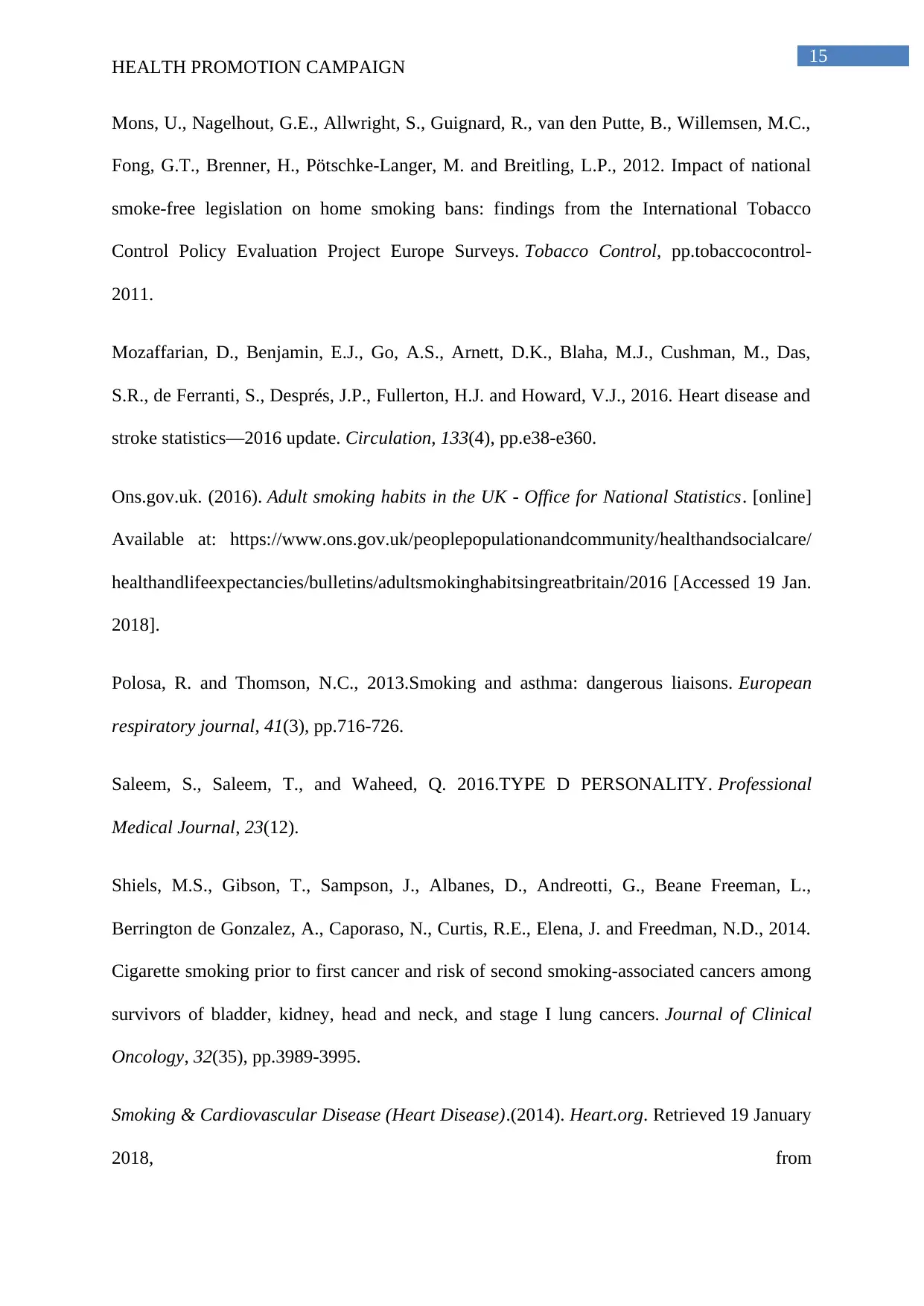
15
HEALTH PROMOTION CAMPAIGN
Mons, U., Nagelhout, G.E., Allwright, S., Guignard, R., van den Putte, B., Willemsen, M.C.,
Fong, G.T., Brenner, H., Pötschke-Langer, M. and Breitling, L.P., 2012. Impact of national
smoke-free legislation on home smoking bans: findings from the International Tobacco
Control Policy Evaluation Project Europe Surveys. Tobacco Control, pp.tobaccocontrol-
2011.
Mozaffarian, D., Benjamin, E.J., Go, A.S., Arnett, D.K., Blaha, M.J., Cushman, M., Das,
S.R., de Ferranti, S., Després, J.P., Fullerton, H.J. and Howard, V.J., 2016. Heart disease and
stroke statistics—2016 update. Circulation, 133(4), pp.e38-e360.
Ons.gov.uk. (2016). Adult smoking habits in the UK - Office for National Statistics. [online]
Available at: https://www.ons.gov.uk/peoplepopulationandcommunity/healthandsocialcare/
healthandlifeexpectancies/bulletins/adultsmokinghabitsingreatbritain/2016 [Accessed 19 Jan.
2018].
Polosa, R. and Thomson, N.C., 2013.Smoking and asthma: dangerous liaisons. European
respiratory journal, 41(3), pp.716-726.
Saleem, S., Saleem, T., and Waheed, Q. 2016.TYPE D PERSONALITY. Professional
Medical Journal, 23(12).
Shiels, M.S., Gibson, T., Sampson, J., Albanes, D., Andreotti, G., Beane Freeman, L.,
Berrington de Gonzalez, A., Caporaso, N., Curtis, R.E., Elena, J. and Freedman, N.D., 2014.
Cigarette smoking prior to first cancer and risk of second smoking-associated cancers among
survivors of bladder, kidney, head and neck, and stage I lung cancers. Journal of Clinical
Oncology, 32(35), pp.3989-3995.
Smoking & Cardiovascular Disease (Heart Disease).(2014). Heart.org. Retrieved 19 January
2018, from
HEALTH PROMOTION CAMPAIGN
Mons, U., Nagelhout, G.E., Allwright, S., Guignard, R., van den Putte, B., Willemsen, M.C.,
Fong, G.T., Brenner, H., Pötschke-Langer, M. and Breitling, L.P., 2012. Impact of national
smoke-free legislation on home smoking bans: findings from the International Tobacco
Control Policy Evaluation Project Europe Surveys. Tobacco Control, pp.tobaccocontrol-
2011.
Mozaffarian, D., Benjamin, E.J., Go, A.S., Arnett, D.K., Blaha, M.J., Cushman, M., Das,
S.R., de Ferranti, S., Després, J.P., Fullerton, H.J. and Howard, V.J., 2016. Heart disease and
stroke statistics—2016 update. Circulation, 133(4), pp.e38-e360.
Ons.gov.uk. (2016). Adult smoking habits in the UK - Office for National Statistics. [online]
Available at: https://www.ons.gov.uk/peoplepopulationandcommunity/healthandsocialcare/
healthandlifeexpectancies/bulletins/adultsmokinghabitsingreatbritain/2016 [Accessed 19 Jan.
2018].
Polosa, R. and Thomson, N.C., 2013.Smoking and asthma: dangerous liaisons. European
respiratory journal, 41(3), pp.716-726.
Saleem, S., Saleem, T., and Waheed, Q. 2016.TYPE D PERSONALITY. Professional
Medical Journal, 23(12).
Shiels, M.S., Gibson, T., Sampson, J., Albanes, D., Andreotti, G., Beane Freeman, L.,
Berrington de Gonzalez, A., Caporaso, N., Curtis, R.E., Elena, J. and Freedman, N.D., 2014.
Cigarette smoking prior to first cancer and risk of second smoking-associated cancers among
survivors of bladder, kidney, head and neck, and stage I lung cancers. Journal of Clinical
Oncology, 32(35), pp.3989-3995.
Smoking & Cardiovascular Disease (Heart Disease).(2014). Heart.org. Retrieved 19 January
2018, from
Secure Best Marks with AI Grader
Need help grading? Try our AI Grader for instant feedback on your assignments.

16
HEALTH PROMOTION CAMPAIGN
http://www.heart.org/HEARTORG/HealthyLiving/QuitSmoking/QuittingResources/
Smoking-Cardiovascular-Disease_UCM_305187_Article.jsp#.WmG1iKiWbIU
Use of e-cigarettes (vapourisers) among adults in Great Britain. (2017). 1st ed. Action on
Smoking and Health, pp.1-3.
Yang, S., Decker, A. and Kramer, M.S., 2013.Exposure to parental smoking and child growth
and development: a cohort study. BMC pediatrics, 13(1), p.104.
HEALTH PROMOTION CAMPAIGN
http://www.heart.org/HEARTORG/HealthyLiving/QuitSmoking/QuittingResources/
Smoking-Cardiovascular-Disease_UCM_305187_Article.jsp#.WmG1iKiWbIU
Use of e-cigarettes (vapourisers) among adults in Great Britain. (2017). 1st ed. Action on
Smoking and Health, pp.1-3.
Yang, S., Decker, A. and Kramer, M.S., 2013.Exposure to parental smoking and child growth
and development: a cohort study. BMC pediatrics, 13(1), p.104.
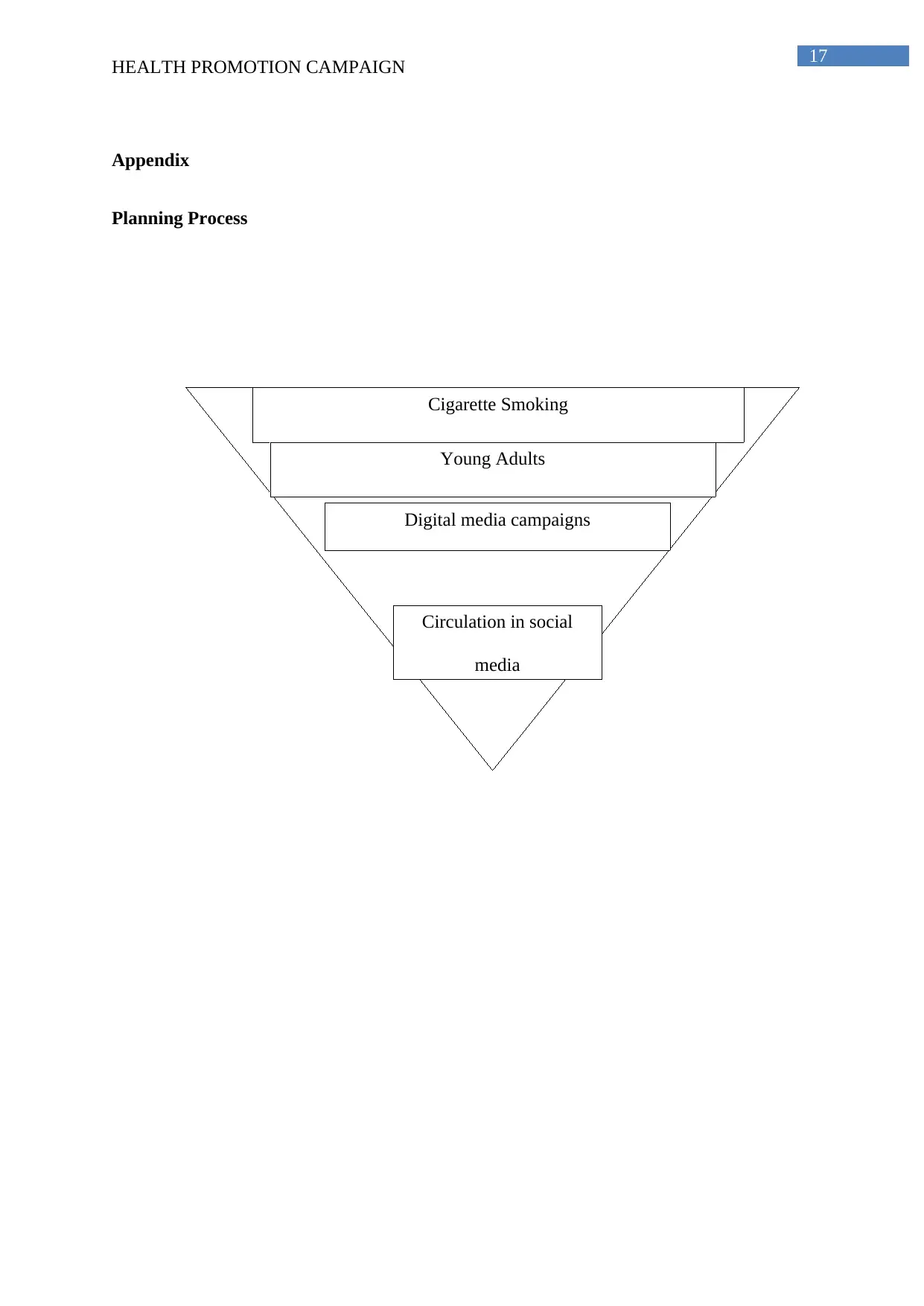
17
HEALTH PROMOTION CAMPAIGN
Appendix
Planning Process
Circulation in social
media
Digital media campaigns
Cigarette Smoking
Young Adults
HEALTH PROMOTION CAMPAIGN
Appendix
Planning Process
Circulation in social
media
Digital media campaigns
Cigarette Smoking
Young Adults

18
HEALTH PROMOTION CAMPAIGN
Time Plan
Month 1 Month 2 Month 3 Month 4 Month 5
Assuming the
%of smoking
among the
chosen
population
(survey)
Selection of
content
Designing of
digital
campaigns
Circulating the
campaign on
social media
and other
websites and
ads
Estimation of
success via
survey among
target
population
HEALTH PROMOTION CAMPAIGN
Time Plan
Month 1 Month 2 Month 3 Month 4 Month 5
Assuming the
%of smoking
among the
chosen
population
(survey)
Selection of
content
Designing of
digital
campaigns
Circulating the
campaign on
social media
and other
websites and
ads
Estimation of
success via
survey among
target
population
Paraphrase This Document
Need a fresh take? Get an instant paraphrase of this document with our AI Paraphraser

19
HEALTH PROMOTION CAMPAIGN
Digital Media Campaign Flyers
HEALTH PROMOTION CAMPAIGN
Digital Media Campaign Flyers
1 out of 20
Related Documents
Your All-in-One AI-Powered Toolkit for Academic Success.
+13062052269
info@desklib.com
Available 24*7 on WhatsApp / Email
![[object Object]](/_next/static/media/star-bottom.7253800d.svg)
Unlock your academic potential
© 2024 | Zucol Services PVT LTD | All rights reserved.





